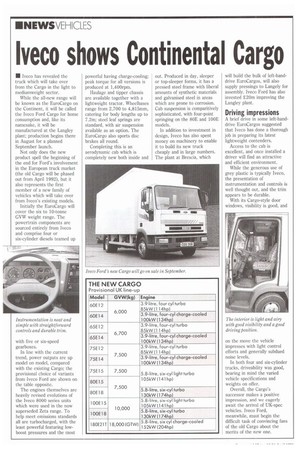Iveco shows Continental Cargo
Page 12

If you've noticed an error in this article please click here to report it so we can fix it.
• Iveco has revealed the truck which will take over from the Cargo in the light to mediumweight sector.
While the all-new range will be known as the EuroCargo on the Continent, it will be called the Iveco Ford Cargo for home consumption and, like its namesake, it will be manufactured at the Langley plant; production begins there in August for a planned September launch.
Not only does the new product spell the beginning of the end for Ford's involvement in the European truck market (the old Cargo will be phased out from April 1992), but it also represents the first member of a new family of vehicles which will take over from Iveco's existing models.
Initially the EuroCargo will cover the six to 10-tonne GVW weight range. The powertrain components are sourced entirely from Iveco and comprise four or six-cylinder diesels teamed up with five or six-speed gearboxes.
In line with the current trend, power outputs are up model on model, compared with the existing Cargo; the provisional choice of variants from Iveco Ford are shown on the table opposite.
The engines themselves are heavily revised evolutions of the Iveco 8000 series units which were used in the now superseded Zeta range, To help meet emissions standards all are turbocharged, with the least powerful featuring lowboost pressures and the most powerful having charge-cooling; peak torque for all versions is produced at 1,400rpm, Haulage and tipper chassis are available together with a lightweight tractor. Wheelbases range from 2,700 to 4,815mm, catering for body lengths up to 7.2m; steel leaf springs are standard, with air suspension available as an option. The EuroCargo also sports disc brakes all round.
Completing this is an aerodynamic cab which is completely new both inside and out. Produced in day, sleeper or top-sleeper forms, it has a pressed steel frame with liberal amounts of synthetic materials and galvanised steel in areas which are prone to corrosion. Cab suspension is comparitively sophisticated, with four-point springing on the 80E and 100E models.
In addition to investment in design, Iveco has also spent money on machinery to enable it to build its new truck cheaply and in large numbers. The plant at Brescia, which will build the bulk of left-handdrive EuroCargos, will also supply pressings to Langely for assembly. Iveco Ford has also invested £20m improving the Langley plant.
Driving impressions
A brief drive in some left-handdrive EuroCargos suggested that Iveco has done a thorough job in preparing its latest lightweight contenders.
Access to the cab is excellent, and once installed a driver will find an attractive and efficient environment.
While the generous use of grey plastic is typically Iveco, the presentation of instrumentation and controls is well thought out, and the trim appears to be durable.
With its Cargo-style door windows, visibility is good, and on the move the vehicle impresses with light control efforts and generally subdued noise levels.
In both four and six-cylinder trucks, driveability was good, bearing in mind the varied vehicle specifications and weights on offer.
Overall, the Cargo's successor makes a positive impression, and we eagerly await the arrival of UK-spec vehicles. Iveco Ford, meanwhile, must begin the difficult task of convincing fans of the old Cargo about the merits of the new one.












































































